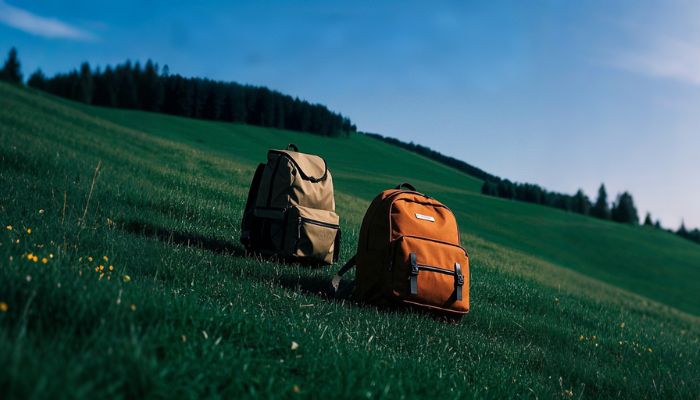
In our daily lives, backpacks are omnipresent, evolving from mere utilitarian carriers to essential items that seamlessly blend functionality, fashion, and personal style. Their journey, from being exclusive to military and outdoor activities to becoming an integral part of our daily routines, mirrors the progression of human needs and the refinement of design and craftsmanship.
Introduction
Definition and History of Backpacks
A backpack, essentially a load-bearing container, has roots that stretch back to ancient times. Initially, humans crafted rudimentary carrying tools using animal skins and plant fibers, laying the groundwork for the modern-day backpack. As time unfolded, backpacks found their niche in military operations and outdoor adventures. During wartime, soldiers relied on them to tote weapons, rations, and other essentials, with design emphasis on practicality and durability. In the realm of outdoor exploration, backpacks evolved to adapt to diverse terrains and environmental conditions.
Post-Industrial Revolution, advancements in production technology revolutionized backpack manufacturing. From simple hand-made beginnings, backpacks transitioned to large-scale mechanized production, leading to a proliferation of styles and varieties. Today, they have transcended their functional origins and become a staple of fashion, firmly ingrained in our daily lives.
Significance of Backpacks in Modern Society
Backpacks are the unsung heroes of modern life, playing pivotal roles in daily routines, travel escapades, work settings, and academic pursuits. In daily life, they are the go-to companions for commuting, shopping sprees and running errands. For globetrotters, they are the trusty vessels that carry travel essentials, enabling seamless exploration of the world. In the workplace, they safeguard documents, laptops, and other work-related items. For students, they are the indispensable carriers of textbooks, notebooks, and stationery, facilitating the learning process.
Types of Backpacks
Daily Backpacks
Daily backpacks are the most prevalent type in our daily lives. Their design philosophy centers around simplicity, elegance, practicality, and comfort. With a moderate capacity, they are tailor-made for carrying daily essentials such as notebooks, documents, wallets, and water bottles. Ideal for work, school, or shopping, some daily backpacks even incorporate trendy elements, doubling as stylish fashion accessories to complement outfits.
Outdoor Backpacks
Outdoor backpacks are engineered with durability and versatility in mind, catering to the rigors of outdoor activities. Mountaineering backpacks, for instance, are constructed from high – strength materials, boasting excellent waterproof and wear – resistant properties. Their meticulously designed load – bearing systems efficiently distribute weight, alleviating pressure on the shoulders and back, ensuring comfort during long – distance hikes and climbs. Equipped with multiple pockets and hanging points, they provide convenient storage for mountaineering gear like ropes, ice axes, and tents.
Camping backpacks, on the other hand, prioritize capacity and space optimization, capable of accommodating a plethora of camping essentials such as tents, sleeping bags, and cooking utensils. To withstand the outdoor environment, they also feature robust waterproof and moisture – proof capabilities.
Travel Backpacks
Travel backpacks are designed with large capacity and comfort as top priorities to meet the demands of long-distance travel. Sporting multiple compartments and partitions, they simplify the organization and storage of travel items, including clothes, toiletries, and electronics. Some travel backpacks come equipped with adjustable shoulder straps, waist belts, and chest straps, along with a comfortable back-support system, ensuring travelers remain at ease even during extended periods of carrying. Additionally, many are equipped with wheels and telescoping handles, enabling easy mobility, much like suitcases.
Laptop Backpacks
With the proliferation of electronic devices, laptop backpacks have emerged as a specialized category. These backpacks are specifically designed to carry laptops and other electronic gadgets. They feature a dedicated laptop compartment lined with soft materials and enhanced with thickened protective designs to shield laptops from collisions and scratches. Complemented by multiple small pockets and compartments, they provide storage for power adapters, mice, documents, and other accessories.
Fashion Backpacks
Fashion backpacks are all about design and keeping up with the latest fashion trends, emphasizing style and personalization. They often flaunt unique materials, colors, patterns, and novel shape designs, making them the focal point of daily outfits for fashion enthusiasts. Beyond functionality, they serve as a medium for expressing one’s personality and taste, embodying the essence of fashion trends.
Materials of Backpacks
Nylon
Nylon is a staple material in backpack manufacturing, renowned for its durability, waterproof properties, and lightweight nature. Backpacks made from nylon can endure substantial tensile forces and wear and tear, resisting breakage, making them a prime choice for outdoor activities. Its waterproof capabilities ensure that the contents remain dry in wet conditions. Moreover, nylon – made backpacks are relatively lightweight, minimizing the burden on the user.
Canvas
Canvas, a classic and sturdy material, exudes a strong retro charm. Canvas backpacks typically have a thick texture and a comfortable hand – feel, projecting an image of simplicity and durability. While its waterproof performance may not match that of nylon, canvas can be treated to acquire a certain degree of water – resistance. Ideal for those with a penchant for retro styles and natural textures.
Leather
Leather, a high – end backpack – making material, is commonly used in business or fashion – oriented backpacks. Leather backpacks feature a distinct texture and luster, exuding an air of nobility and elegance. Their durability is also remarkable, with proper maintenance allowing them to last for an extended period. However, they are relatively heavy, come with a higher price tag, and require regular maintenance to preserve their appearance and performance.
Polyester Fiber
Polyester fiber, a synthetic fiber, offers the trifecta of wear – resistance, durability, and cost – effectiveness. Its performance is comparable to nylon, but at a more affordable price point, making it a popular choice for many backpacks. Polyester – fiber backpacks are easy to clean and maintain, and they resist deformation, making them suitable for a wide range of daily – use scenarios.
Eco-friendly Materials
With the growing global awareness of environmental protection, an increasing number of brands are embracing recyclable or eco-friendly materials in backpack production. Some backpacks are crafted from recycled polyester fiber, organic cotton, and other eco-materials. These not only reduce environmental pollution but also cater to the rising demand for sustainable products. Backpacks made from eco-friendly materials are on par with traditional counterparts in terms of performance while reflecting the brand’s commitment to social responsibility and sustainable development.
Functionality and Design of Backpacks
Capacity and Compartmentalization
The choice of backpack capacity should be tailored to the usage scenario and personal needs. Daily backpacks typically range from 10 – 30 liters, sufficient for carrying daily essentials. Outdoor backpacks vary in capacity depending on the activity type and duration; mountaineering backpacks usually range from 30 – 80 liters, while camping backpacks may be even larger. Travel backpacks generally have a capacity of 40 – 80 liters to accommodate travel-related items.
A well-thought-out compartmentalization design can significantly enhance a backpack’s practicality. Many backpacks are equipped with multiple zippered pockets, compartments, and pouches for easy item categorization. The main compartment is suitable for larger items like clothes and books; internal small compartments can store valuables such as wallets, IDs, and mobile phones; and external pockets are convenient for frequently-used items like water bottles and umbrellas.
Comfort
Comfort is a crucial consideration when choosing a backpack. The design of the shoulder straps directly impacts carrying comfort. Wide and thick shoulder straps can evenly distribute the weight, reducing shoulder strain. Some high-end backpacks incorporate soft padding on the shoulder straps for enhanced comfort. Additionally, the back-support system is of utmost importance. A good back-support system can relieve back stress and prevent back pain during long-term carrying. Some backpacks feature ergonomic back designs, such as S-shaped back panels and breathable mesh, to enhance back comfort.
For outdoor and travel backpacks, the waist belt is an essential comfort – enhancing feature. It can transfer the backpack’s weight to the hips, further reducing shoulder and back pressure, enabling users to stay comfortable during long – distance walks.
Waterproof and Durability
Backpacks need to exhibit appropriate waterproof and durable properties in different environments. Waterproofing is particularly crucial for outdoor activities and travel, safeguarding the contents from rain. Some backpacks use waterproof fabrics like treated nylon or polyester fiber, and waterproof tapes at the seams to ensure overall water – resistance. High – end backpacks often come with detachable rain covers for added protection during heavy rain.
Durability hinges on the backpack’s materials and manufacturing process. High – quality materials and meticulous craftsmanship ensure that the backpack withstands long – term use without easy damage. Reinforced stitching, durable zippers, and fasteners are key factors in enhancing backpack durability.
Safety Design
With the evolution of society, the safety design of backpacks has garnered increasing attention. Some backpacks are equipped with lockable zippers to deter theft; hidden pockets provide a secure storage option for valuables; and anti – theft designs, such as unique zipper placements and cut – resistant fabrics, offer users peace of mind during travels.
Tips for Choosing a Backpack
Usage Scenario
Selecting the right backpack type based on the usage scenario is vital. For daily commuting, a simple and lightweight daily backpack suffices. For outdoor activities like mountaineering and hiking, a professional outdoor backpack with a reliable load – bearing system, durability, and waterproofing is essential. For long – distance travel, a large – capacity and comfortable travel backpack is the better choice. If you frequently carry electronic devices like laptops, a laptop backpack offers superior protection and convenience.
Comfort and Fit
The comfort and fit of a backpack directly influence the user experience. When choosing a backpack, pay attention to the width and softness of the shoulder straps and the design of the back – support. During a trial – fit, adjust the shoulder straps and waist belt to ensure the backpack conforms to the body and the weight is evenly distributed. Also, ensure the backpack’s size is appropriate for your body; an ill – fitting backpack can compromise comfort and the carrying experience.
Material and Durability
Choose the appropriate material according to your usage needs, while also considering durability and maintenance ease. For frequent outdoor activities, opt for durable and waterproof materials like nylon or treated polyester fiber. If you’re after fashion and texture, leather or canvas backpacks are options, but be aware of the maintenance requirements for leather. Additionally, inspect the manufacturing process, such as the firmness of stitching and the durability of zippers and fasteners, to ensure the backpack’s quality and longevity.
Budget and Cost-effectiveness
Backpacks vary widely in price across different brands and styles. When choosing a backpack, set a budget and comprehensively evaluate the backpack’s functions, quality, and price to select a cost – effective product. Avoid sacrificing quality and performance for a low price, and don’t over – splurge on high – end brands without due consideration. Compare different brands and styles to choose the one with the best performance within your budget.
Popular Trends of Backpacks
Integration of Functionality and Fashion
Modern backpacks are not just about functionality; they are increasingly incorporating fashion elements. Consumers today seek backpacks that can meet daily practical needs while also expressing their individuality and taste. As a result, many brands are skillfully blending functionality and fashion in their designs, introducing a range of products that are both practical and stylish. For example, some outdoor backpacks maintain their professional performance while adopting trendy colors and patterns; some daily backpacks enhance their functionality with multi-functional pockets and compartments.
Eco-friendly and Sustainable Design
With the growing environmental consciousness, eco – friendly and sustainable design has emerged as a significant trend in the backpack industry. Many brands are now using recyclable materials, organic materials, or eco – friendly dyes in backpack production to minimize environmental impact. Simultaneously, some brands focus on product sustainability, such as using durable materials and manufacturing processes to extend the backpack’s lifespan and introducing recyclable product packaging.
Smart Backpacks
With the continuous advancement of technology, smart backpacks are making their way into our lives. These backpacks typically integrate intelligent technologies like charging modules, Bluetooth functions, and GPS positioning, offering users enhanced convenience and functionality. For example, some smart backpacks have built-in power banks for charging mobile phones and tablets; some can be connected to mobile phones via Bluetooth for remote control and data transfer; and some are equipped with GPS systems to help users track their location during outdoor activities. In the future, the functions of smart backpacks are expected to expand and improve, becoming even more indispensable in our lives.
Maintenance and Cleaning of Backpacks
Daily Care
Daily care is essential for maintaining a backpack’s appearance and functionality. Regularly clean the backpack to remove surface dust and stains. For regular backpacks, a damp cloth wipe suffices. For easily soiled areas like the bottom and shoulder straps, use a mild detergent. Avoid exposing the backpack to direct sunlight for extended periods to prevent color fading and material aging. Also, be cautious to avoid contact with sharp objects to prevent scratches.
Deep Cleaning
Backpacks made of special materials like canvas or leather require periodic deep cleaning. Canvas backpacks can be cleaned with a brush and detergent, but be gentle to avoid fabric damage. After cleaning, let them air-dry naturally, away from direct sunlight. Leather backpacks need to be cleaned and maintained with specialized leather cleaners and maintenance oils. Regular application of maintenance oil can preserve the leather’s softness and luster, prolonging the backpack’s service life.
Storage Tips
Proper storage is key to preventing backpack damage and deformation. When not in use, empty the backpack and organize its internal compartments and pockets. You can hang it on a hanger or store it in a dry, ventilated place. Avoid placing heavy objects on the backpack to prevent deformation. For long-term storage, fill the backpack with soft items like newspapers or towels to maintain its shape.
Innovation and the Future of Backpacks
Application of New Technologies
In the backpack domain, the application of new technologies is constantly driving product innovation and development. The use of antibacterial fabrics, for example, can effectively prevent bacterial growth, maintaining a clean and hygienic interior. New waterproof technologies have further enhanced backpack waterproof performance. Seamless welding technology not only improves durability and waterproofing but also gives the backpack a more streamlined and aesthetically pleasing appearance. Additionally, the application of high-tech materials like carbon fiber and graphene has brought breakthroughs in backpack design and performance.
Future Development Trends
The future of the backpack market is poised to be characterized by greater intelligence, multi-functionality, and personalization. With technological advancements, smart backpacks will see further functional expansion, such as integrating more sensors for health monitoring, environmental monitoring, and more. The multi-functional design of backpacks will also continue to evolve, with additional features like lighting and communication being added to meet diverse needs. Moreover, the growing demand for personalization will fuel innovation in backpack design, with brands focusing more on personalized customization to cater to the unique preferences of different consumers.
Conclusion
Backpacks, an indispensable part of our lives, have become increasingly diverse in terms of types, materials, functions, and designs. From daily use to outdoor adventures, from fashion statements to technological innovation, backpacks play a significant role in modern life. By delving into the history, types, materials, functionality, design, brand recommendations, selection tips, popular trends, maintenance, and cleaning, as well as innovation and the future of backpacks, we can make more informed decisions when choosing the right backpack for different scenarios.
When selecting a backpack, it is advisable to first clarify your usage scenarios and needs, and then comprehensively consider factors such as comfort, material, durability, and budget. Pay attention to the brand and quality, choosing reputable brands and products. Additionally, you can select a backpack that is both practical and aesthetically pleasing according to your personal preferences and fashion sense, making it a reliable companion in your life. Whether you’re navigating the urban jungle or exploring the great outdoors, a suitable backpack can add convenience and joy to your journey.



